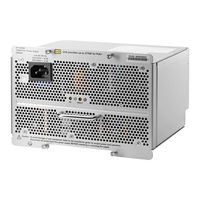Hewlett Packard Enterprise Aruba 5400R Manuals
Manuals and User Guides for Hewlett Packard Enterprise Aruba 5400R. We have 1 Hewlett Packard Enterprise Aruba 5400R manual available for free PDF download: Management And Configuration Manual
Hewlett Packard Enterprise Aruba 5400R Management And Configuration Manual (861 pages)
ArubaOS Switch 16.08
Brand: Hewlett Packard Enterprise
|
Category: Switch
|
Size: 13 MB
Table of Contents
-
-
Ntp34
-
-
Timesync34
-
Timesync Ntp35
-
-
-
Ntp35
-
[No] Ntp35
-
Ntp Enable36
-
Ntp Server38
-
Debug Ntp41
-
Ntp Trap41
-
-
Timesync48
-
-
-
-
No Ip Timep71
-
No Timesync71
-
No Ip Timep72
-
Timesync72
-
No Sntp73
-
Ip Timep74
-
-
-
-
-
Services84
-
Device84
-
-
Command Name91
-
-
-
Command Name92
-
-
-
Module Type93
-
-
-
Transceivers94
-
Modules94
-
-
Fans98
-
-
-
-
Show Interfaces110
-
-
-
Command Name114
-
-
-
Interface117
-
-
-
Usb-Port119
-
Show Usb-Port119
-
-
-
Enabling UDLD128
-
-
Manual Override134
-
-
-
Configuring UDLD136
-
Prerequisites137
-
-
-
Overview146
-
Restrictions150
-
Show Logging150
-
-
-
-
Poe151
-
Poe Terminology151
-
-
Poe Operation152
-
-
Interface157
-
-
-
Int158
-
-
-
Lldp Config162
-
-
-
Lldp Config164
-
-
-
Show Lldp Config165
-
-
-
LLDP with Poe173
-
Operation Note174
-
-
-
-
-
-
Show Trunks176
-
-
-
Show Lacp177
-
-
-
Trunk177
-
-
-
No Trunk178
-
-
Set the LACP Key179
-
Lacp179
-
-
-
Limitations183
-
-
-
Show Trunks186
-
Operating Notes187
-
-
-
-
Trunk188
-
-
-
Fault Tolerance191
-
-
-
Static Trunk193
-
-
-
Port Security204
-
-
-
-
Operating Notes228
-
-
Jumbo Frames236
-
Operating Rules236
-
Troubleshooting242
-
-
Fault Finder242
-
-
-
-
Setmib249
-
-
-
Show Interfaces250
-
-
-
Rmon Alarm252
-
Advertisement
Advertisement
Related Products
- Hewlett Packard Enterprise 5920 Series
- Hewlett Packard Enterprise 5900 Series
- Hewlett Packard Enterprise FlexFabric 5940 Series
- Hewlett Packard Enterprise Aruba 3810
- Hewlett Packard Enterprise Aruba 2920
- Hewlett Packard Enterprise Aruba 2530
- Hewlett Packard Enterprise Aruba 6200F
- Hewlett Packard Enterprise Aruba 8360 Series
- Hewlett Packard Enterprise Aruba 8360 32Y4C
- Hewlett Packard Enterprise Aruba 8360 16Y2C
